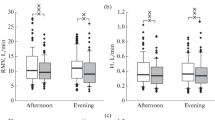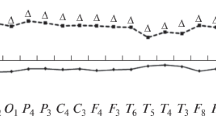Abstract
Characteristics of the energy metabolism, external ventilation, and spectral characteristics of the EEG in an examination situation were studied in students with high and low neuroticism and situational anxiety. Higher energy expenditures, CO2 concentration, and the value of ΔO2 in the exhaled air were observed in students with high neuroticism and situational anxiety during the stressful preexam situation. In addition, they were characterized by more pronounced Δ-rhythm in the EEG spectra on right derivations and θ-rhythm in EEG spectra of both frontal and right central and parietal regions of the cortex. High values of the respiratory quotient, flow rate, and respiration frequency were observed in students with low neuroticism and situational anxiety before the examination at heightened energy expenditures. They did not display a more pronounced Δ- and θ-rhythms in EEG spectra of the analyzed cortex areas.
Similar content being viewed by others
REFERENCES
Sudakov, K.V., Individual Resistance to Emotional Stress, Moscow: Anokhin Inst. Norm. Physiol., 1998.
Sudakov, K.V., Yumatov, E.A., General Methodological Approaches to the Problem of Psychoemotional Stress, in Emotsionalnyi stress: teoreticheskiye i klinicheskiye aspekty (Emotional Stress: Theoretical and Clinical Aspects), Sudakov, K.V., Petrov, V.I., Ed., Volgograd: Committee on Press and Information, 1997, p. 14.
Luchshiye psikhologicheskiye testy dlya profotbora i proforientatsii (The Best Psychological Tests for Career-Guidance), Kudryavtseva, A.F., Ed., Petrozavodsk: Petrokom, 1992, p. 38.
Rusalov, V.M., A New Adaptation of the Personality Test EPI, Psikhol. Zh., 1987, vol. 8, no. 1, p. 113.
Davidson, R.J., Cerebral Asymmetry and the Study of Individual Differences and Psychopathology, in General Dynamics and Psychopathology, Takanashi, R., et al., Eds., Amsterdam: Elsevier, 1987, p. 71.
Siomonov, P.V., Functional Asymmetry of the Frontal Neocortex and Emotions, Dokl. Ross. Akad. Nauk, 1994, vol. 338, no. 5, p. 689.
Walter, G., The Living Brain, Moscow: Mir, 1966.
Simonov, P.V., Emotsional'nyi mozg (The Emotional Brain), Moscow: Nauka, 1981.
Strelets, V.B, Samko, N.N., Golikova, Zh. V., Physiological Characteristics of the Preexamination Stress, Zh. Vysch. Nervn. Deyat., 1998, vol. 48, no. 3, p. 458.
Strelets, V.B., Danilova, N.N., Kornilova, I.V., Rhythms of the EEG and Psychological Characteristics of Emotions at Reactive Depression, Zh. Vysch. Nervn. Deyat., 1997, vol. 47, no. 3, p. 11.
Dzhebrailova, T.D., Korobeinikova, I.I., Ivanova, L.V., Umryukhin, E.A., Relaxing Effects of Local Hot-Air Action at Stressful Loads in Students, Vestn. Ross. Akad. Med. Nauk., 1998, no. 2, p. 14.
Author information
Authors and Affiliations
Rights and permissions
About this article
Cite this article
Umryukhin, E.A., Dzhebrailova, T.D., Korobeinikova, I.I. et al. Energy Metabolism and Spectral EEG Characteristics of Students with Different Neuroticism and Anxiety Levels in an Examination Stress Situation. Human Physiology 28, 183–187 (2002). https://doi.org/10.1023/A:1014810316556
Issue Date:
DOI: https://doi.org/10.1023/A:1014810316556




